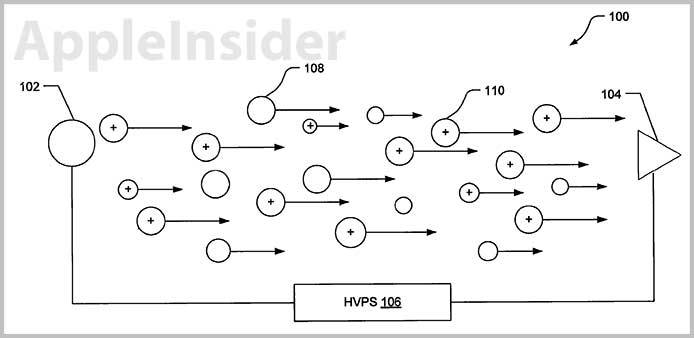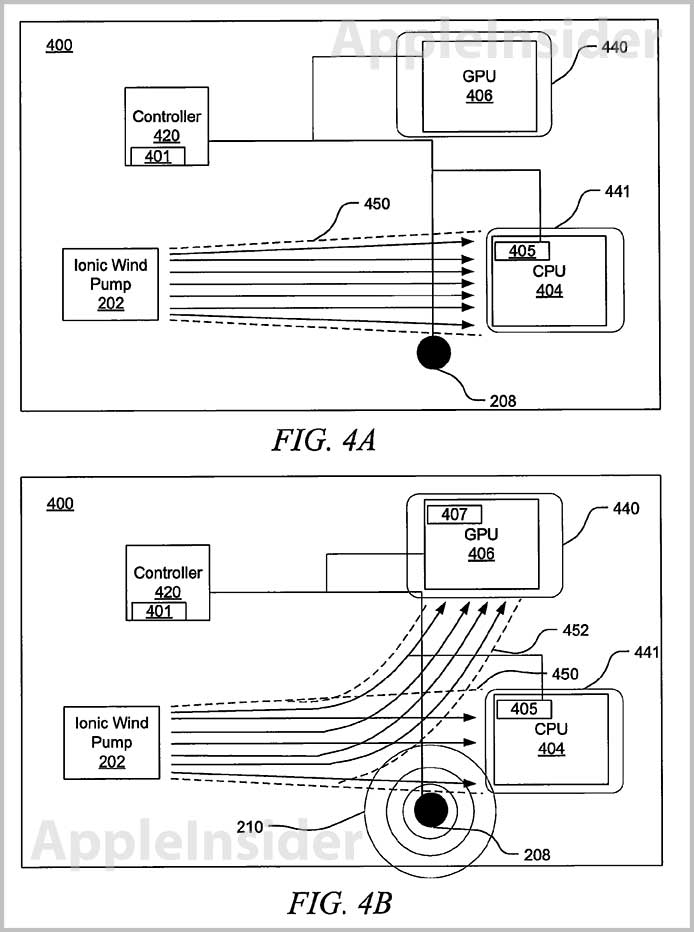The U.S. Patent and Trademark Office on Tuesday issued Apple a patent for a cooling system that blows ionized air through an electronic device, controlling its path by creating electromagnetic fields that can be dynamically adjusted to direct cooling where it's needed most.
Apple's U.S. Patent No. 8,305,728 for "Methods and apparatus for cooling electronic devices," describes a system in which the direction of ionized air moving through a computing device is deflected by either an electric or magnetic field. Currently, mechanical fans pull in air and push it through predetermined physical paths within a computer, usually over passive heat exchangers, and out through an exhaust port.
Driving the air in Apple's system is the ionic wind generator, basically a solid-state air mover based on "corona discharge— an electrical discharge near a charged conductor caused by the ionization of the surrounding air." The system is comprised of a corona electrode, a collector electrode and a high voltage power supply. When voltage is applied to electrodes, an electric field is created and causes particles in the surrounding air to take on a charge, or become ionized. An electric field propels the charged particles toward the collector electrode, which collide with other neutral particles as they move to create to generate "bulk air movement."
As the ionized air moves through the device, it can be deflected or redirected by a "deflection field generator," which can be a magnet or electromagnet. The magnitude of deflection is governed by the Lorentz force, or force on a charged particle from an electromagnetic field, which can be varied by the deflection field generator.
By employing standard issue heat sensors, the ion wind pump and deflection field generator system can direct cooling air to high temperature areas like the CPU or GPU.
The system also solves another problem associated with always-on mechanical fans, the so-called "no slip" condition at the "surface and the mean free stream velocity at the outer reaches from the surface" of a component. When such a condition arises, it creates a boundary layer of air over a component, making heat transfer more difficult. By modulating the rate of deflection, or time in which air flow passes over a component, the system creates eddy currents and turbulent flows to disturb the boundary layer.
Finally, the ionized air exits the device through a vent that is in the path of the ionic pump's normal air flow.
Interestingly, the invention notes that the system is not limited to large desktops and laptops, but in mobile devices such as cell phones and media players as well.
Although such ion wind pump technologies are used in specialized industrial and laboratory settings, a solution has not yet been presented in a consumer device. Apple has shown that it is actively looking to solve issues related to cooling internal components, including noise reduction as seen with the asymmetrical fans in both MacBook Pro with Retina display models (1, 2), however it is unknown if the company will implement the solid state generator any time soon.
 Mikey Campbell
Mikey Campbell
















 William Gallagher
William Gallagher
 Christine McKee
Christine McKee
 AppleInsider Staff
AppleInsider Staff
 Chip Loder
Chip Loder

 Malcolm Owen
Malcolm Owen










38 Comments
Everybody knows Apple is just a design and marketing company. I wish they wouldn't waste the resources of the Patent Office with these fake ideas.
Everybody knows Apple is just a design and marketing company. I wish they wouldn't waste the resources of the Patent Office with these fake ideas.
Sarcasm detected.
Corona wires can produce ozone, which is a strong oxidant and potentially damaging biologically. Guess Apple has considered this issue. Ozone is the 'metallic odour' often produced by photocopiers and laser printers, particularly when warming up.
Corona wires can produce ozone, which is a strong oxidant and potentially damaging biologically. Guess Apple has considered this issue. Ozone is the 'metallic odour' often produced by photocopiers and laser printers, particularly when warming up.
Laser printer factories can cause cancer from ozone, if I recall correctly.
At first glance I read:
Iconic Wind Generator
Say what?
Aha
Anyways. Wow, controlling charged particles with EM field what an invention.